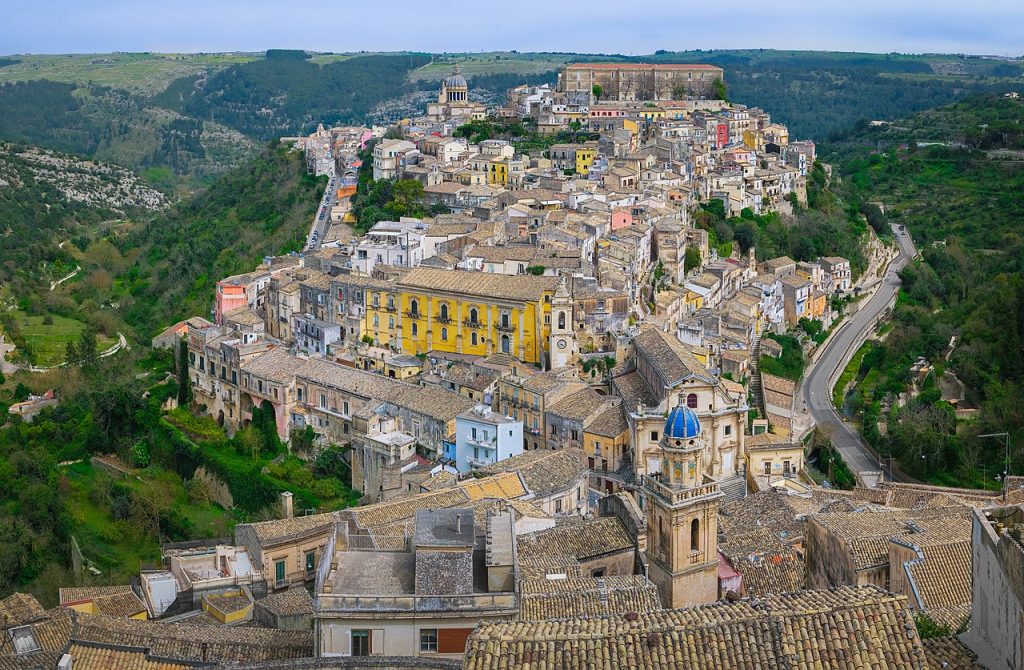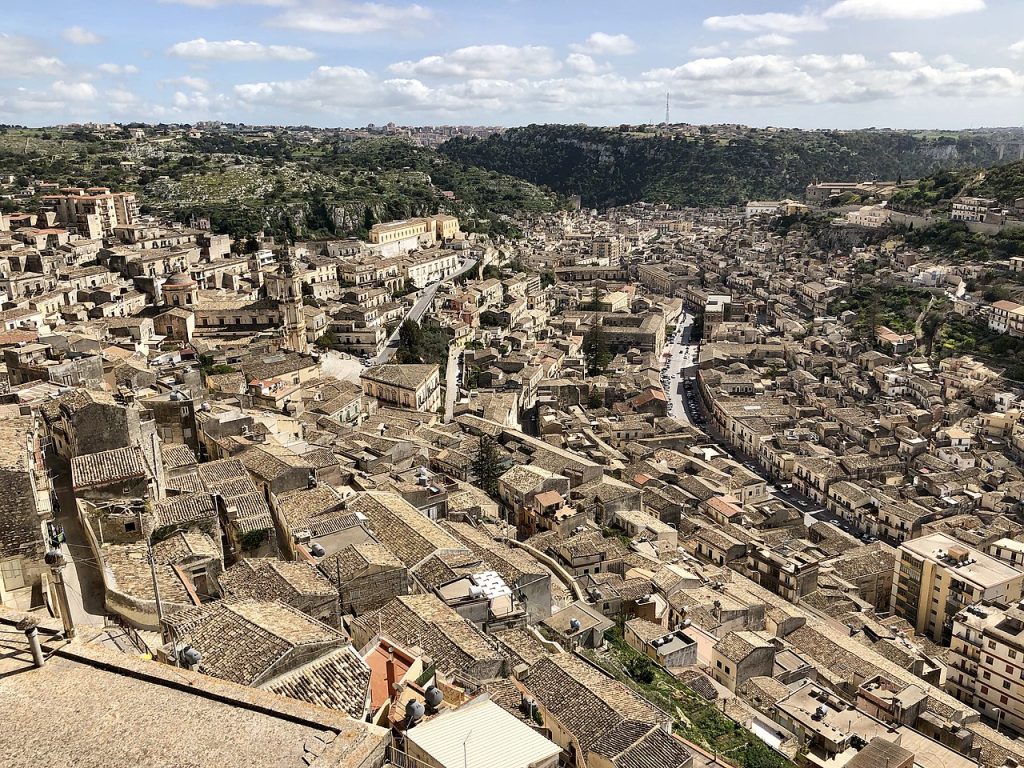Taormina (Taurmina, or Taummina, in Sicilian) is an Italian town of 11,086 inhabitants located in the metropolitan city of Messina, in Sicily.
It is one of the most important international tourist centers of Sicily, known for its natural landscapes, marine beauties and its historical monuments and it has been an important Gran Tour destination. Taormina has been one of the main touristic destinations since the XIX century in Europe.
It is located on a hill at 206 m above sea level, suspended between rocks and sea, on a terrace of Monte Tauro, in a setting of natural beauty, unique for variety and contrasts, on the southern slopes of Peloritani mountains of the Ionian coast with Etna in the background.
There are many news on Taormina origin (Tauromenion, Tauromenium), but uncertain for documentation and reliability.
Diodorus Siculus, in the 14th book of his Bibliotheca historica, attests that the Sicilian people lived in the fortress of Taormina, living in agriculture and cattle breeding, even before the landing of the Greeks calcidesi in the bay (735 b.C.), where at the mouth of the river Alcantara, founded Naxos (today’s Giardini Naxos), the first Greek colony in Sicily. Dionysius of Syracuse, of Doric origin, and an ally of Sparta in the war against Athens, tolerated for a short time the presence of the Jonici of Calcide Eubea in Naxos, allied of Athens, and moved against them. The Calcidesi occupied an area located downstream of Monte Tauro (Sicily), where the Siculi lived together with other Jonic who had previously settled from Naxos.
But in the years of the XCVI Olympiad (396 b.C.) the masses of Nassioti, threatened by Dionysius, Syracuse tyrant, moved to Tauromenion, driven by Imilcone, Carthaginians leader, an ally of the Jonic against the Dorians, since the hill was to be considered fortified by nature. Since Dionisio wanted to take back the territory of the Tauromenitani with violence, they replied that it belonged to them by right, because their Greek ancestors had already taken possession of them before them, driving away the local inhabitants.
Vito Amico states that this version of Taormina origins supplied by Diodoro, is contradicted in the 16th book, when he claims that Andromaco, after the Naxos massacre of 403 b.C., gathered the survivors and convinced them to settle in 358 b.C. on the slopes of the nearby “bull-shaped” hill. The nascent inhabited center took the name of Tauromenion, toponym composed by Toro and the Greek form menein, which means “to stay”.
While the news provided by Cluverio agree with the second version of Diodoro, Strabone tells that Taormina originated from the Zanclei (Messina) and the Nassi. This would clarify in some way the statement of Plinio, who states that Taormina was originally called Naxos.
According to the testimony of Diodorus Siculus, Taormina, wisely governed by Andromachus, progresses, shining in opulence and power. In 345 b.C. Timoleone from Corinth, lands and reaches Tauromenium, to ask for military support in order to support the freedom of the Syracusans.
Tyrant of Siracusa control
Later we find Taormina under the control of Agatocle, the tyrant who commands the killing of several famous people and he exiled Timeo, Andromaco son. Then, Taormina submitted itself to Tindarione, so Gerone, both Siracusa tyrant.
Roman Period
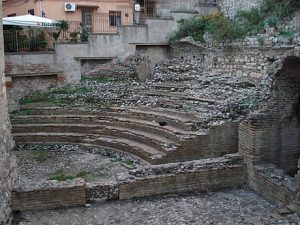
Taormina stays under the Siracusa domain till in 212 b.C, Rome declares all the Sicily a Roman district. Its citizens were considered Roman allied and Cicerone, classified it as “Civitates foederatae” and “Civis Notabilis”. Consequently to that, during emergency, people don’t have to pay the tithe or to supply with arms sailors and vessels.
During the Servil war (134-132 b. C.) Tauromenium was occupied by the rebel slaves, that selected it like sure stronghold. Gripped in siege by Pompilio, they resisted for a long time to the hunger and they gave up only when his chief Odeon Romano Serapione, by betraying his partners, took leave the fortress.
In 36 b. C., during the was between Sesto Pompeo and Ottaviano, the Ottaviano troops disembarked in Naxos just to get back the city. In 21 b. C., to repopulate Tauromenium, after the war, Ottaviano, became Augusto, and sent a faithful Roman community and expelled the citizens against him.
Late Empire and fall of it
According to a legend, with Christianity beginning, Saint Peter addressed in Taormina Pancrazio Bishop, who built the first little church consecrated to Saint Peter and Paul on the eastern slopes of the city, by establishing the first episcopate in Sicily.
Bishops “very proud for the sanctity of customs, zeal and doctrine”, wrote Vito Amico, succeeded each other until the Arab age. Few are the news in this period of time, which includes the fall of the Western Roman Empire in 476, the invasion of the Goths, the presence of the Byzantines and the Arab conquest.
What is certain is that Taormina occupies an important strategic position for the military estate of the surrounding territory, for 62 years it is the last strip of land of the Eastern Roman Empire along with Rometta and several times resists the assaults of the Saracens, until at 906.
904-906 siege and Muslim domain
During Christmas night of 906, after two years of siege, due to a betrayal of Tommaso Balsamo, Taormina was totally razed. According to a medieval history, the male citizens were decapitated and the head of Taormina bishop, Saint Procopio, was delivered to the Saracen chef troops, the aghlabide Ibrahim II. There was a huge massacre, exacerbated by the cruelty of Ibrahim II.
In 911, however, the Christian component of the Sicilian town regained control of the city, taking advantage of the traumatic passage of power of the previous year between the Sunnite Aghlabide dynasty and the Shiite Ismailite of the Fatimids.
The Palermo Emir, Aḥmad b. al-Qurhub, remained loyal to the deposed Aghlabid dynasty of Qayrawan, then organized an expedition to regain control of Taormina, sending in 913 his son Alī to the siege of the town that, however, resisted strenuously, so as to induce the besieger to renounce company.
In 919, the new Palermo Emir, Salim Ibn Rashid, faithful to the Fatimids, gave an armistice to Taormina and other Val Demone fortresses. This period finished when Ahmad Ibn al-Hasan, in 962, putted Taormina in siege for seven months.
the beautiful girls were brought in Al-Mu’izz Imam, while the others became slaves. The few survivors escaped in near mountains. The city was built again in south area, where finished the greek-roman city distracted by Saracens, and for a century, citizens lived in peace and endurance between Christians and Muslims. Muslims adorned it with wonderful gardens and fountains, renaming it Al-Mu’izziyya, from Iaqab of the fourth Imam Fatimid Ma’add, called Al-Mu’izz li-Din Allah (953-075).
1078 siege and Norman-Suevian Domain
The Grand Conte Ruggero took possession of the city, which conquered Castronovo turned to conquer the Val Demone, besieging the city, through the construction of twenty-two forts in timber: trunks and branches form an insurmountable wall; nevertheless the Saracens resist for a long time before capitulating in 1078.
In 1272, Taormina was ruled by Giovanni Natoli Barone of Sparta.
When the Episcopal seat was transferred in Taormina, it became State City, included firstly in Troina Diocese and in Messina one.
Let’s follow the Sicilian events, under Suevian and Aragoneses (1282). In 1410 the Sicilian Parliament, one of the most ancient in Europe, accured in Taormina its historical meeting, in Palazzo Corvaja with the presence of Bianca di Navarra Queen, for the election of Sicilian King, after the death of Martin I, called the young. During the XVI century, Philip IV of Spain grants to the city the privilege to belong permanently to the crown.
Siege of 1675 and French rule
In 1675, on the occasion of the Anti-Spanish Revolt of Messina, Taormina remained loyal to the Crown of Spain. For this reason it was besieged by the French, Messina’s allies who stormed it in September 1676. The Orleans, French, did not consider it an important city, so much so that for a while it was placed under the military jurisdiction of nearby Savoca it was surrendered to the French, concluding with these an advantageous capitulation.
Return of the Bourbons
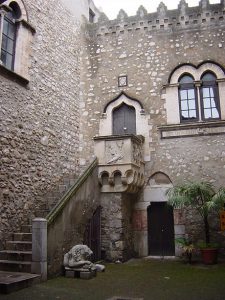
Defeat the French, Taormina returns under the Spanish and the Vicerè with the ancient privileges. Later, with the occupation of the Napoleonic troops of Naples and the South and with the transfer of the Bourbon Palace to Palermo, the king Ferdinando I of Sicily wanted to thank Taormina for its ancient loyalty to the Bourbons against the French. The king, on an official visit to the faithful Taormina, as a sign of recognition, donated to the mayor of that period, Pancrazio Ciprioti, the Isola Bella.
The Bourbons, made easier access to the city, which, since Roman times, was from the narrow Consular Valeria that climbed between the hills, cutting the promontory of Catrabico, thus creating a coastal road that easily joined Messina to Catania.
On the part of many European nations and famous writers and artists (Goethe, Maupassant, Houel and others) there was an interest in the amenity of the place and its archaeological beauties. From now, Taormina will develop, becoming a place of residence for élite tourism, initially coming mainly from England as Florence Trevelyan (1852-1907), daughter of Edward Spencer Trevelyan (1805-1854) and Catherine Ann Forster (1815-1877 ). After a long journey and a return home, Trevelyan decided to return and live in Taormina that transformed Palazzo Corvaja (of the XII and XIII) radically, together with its surrounding, then marrying Salvatore Cacciola, teacher of surgery at the University of Bologna, mayor of Taormina for over twenty years between ups and downs, as well as first Grand Master Freemason and finally enlightened theosophist.
From the 19th century till the present
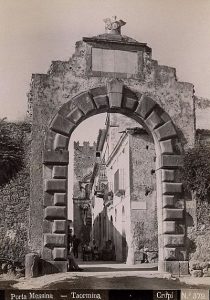
Florence Trevelyan Trevelyan first helped the La Floresta to expand the first hotel in Taormina, Hotel Timeo, and later bought the rock of St. Stephen, turning it into an earthly paradise nicknamed then Isola Bella during a discussion between her and the German baron and homosexual photographer Wilhelm von Gloeden (1856 – 1931). She bought 87 plots of land to create between 1897 and 1898 the park that baptized “Hallington Siculo” in honor of Hallington Hall, the small village where he had lived, about two miles southwest of the town of Louth, in Lincolnshire. After his death, the Park was expropriated by Cesare Acrosso, the only male nephew of his husband Salvatore Cacciola, in league with “Don” Giovanni Colonna, Duke of Cesarò, who was given the Park without merit, because he – cowardly – was not even among the signers of the Royal Decree Law 528 of 18 February 1923.
From England came King Edward VII in 1906 and in 1908, from Germany characters like Johann Wolfgang von Goethe, who quoted Taormina in his Journey in Italy (Italienische Reise), the baron photographer Wilhelm von Gloeden, the painter Otto Geleng, Friedrich Nietzsche, from 1882, who wrote Così parlò Zarathustra, Richard Wagner, the Tsar Nicholas I, the Kaiser Wilhelm II of Germany with his cousin Tsar Nicholas II, the Zarina Aleksandra Fëdorovna Romanova niece of Queen Victoria as daughter of Alice of England with friends, Ignazio Florio and Franca Florio, “the star of Italy” as the Kaiser and friend of Trevelyan called her, Gabriele D’Annunzio, Gustav Klimt, Sigmund Freud, Edmondo De Amicis, Grand Duke Paul of Russia, Prince Jusupov Feliks with Princess Irina, Archduke Mihail Pavlopic brother of Tsar Nicholas II and bankers, magnates, aristocrats from around the world.
Soon Taormina became famous all over the world, both for its scenic beauty, for its panoramas, for its colors, for the paintings of the snow-covered and smoking Etna that descends to the turquoise sea and that went around the world, but also for its permissiveness, for its “transgression”, for its “learned cenacles”, for the “myth of Arcadia”, for its unbridled “dolce vita“.
The writer Massimo Simili describes a period in which not a day passed that in Taormina did not happen something “crazy” thanks to his whimsical and famous goers. What was allowed in Taormina created a scandal even in the “international” Capri where, for example, the German Krupp gunner had tried, without success, to recreate the “Taorminesi cenacoli” in which efebilocali and maidservants were at the center of the “scenes”. Krupp in Capri was overwhelmed by the scandal and a few days later he took his life for shame in Brema.
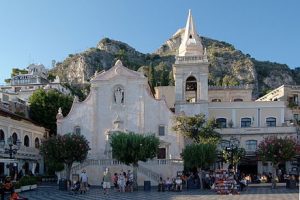
Many hotels were built, all run by Taormina families. The country of fishermen and peasants and wealthy bourgeois became therefore a small town of traders, hoteliers, builders. During the Second World War it was the seat of the German Wehrmacht Command, for which on 9th July 1943, the day of the patron Saint Pancrazio Bishop, Taormina suffered two devastating bombings of the allied aircraft that destroyed part of the southern area and even a wing of the famous hotel San Domenico, where a meeting of the German high command was under way.
International touristic city
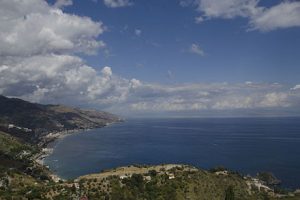
As international touristic city, several English spies disguised theirselves during the Fascism and marched when the allied troops entered. During the post war, Taormina increased without compromising her natural beauties and, till 1968 it was a winter touristic city, only for rich tourist, in fact the best hotels were opened only from October till June. Taormina was attended by famous writers like Roger Peyrefitte, Truman Capote, André Gide, D.H. Lawrence, Salvatore Quasimodo, Tennessee Williams, the Russian Anna Achmatova, by aristocrat people, like Giuliana d’Olanda, from the Suevian and Denmark royals, from the Finland President Urho Kekkonen, from famous people like Soraya, Ava Gardner, Romy Schneider, who made friends with fascinates local playboys, and also Liz Taylor, Richard Burton, Dino Grandi, Willy Brandt, Greta Garbo, who spent months in Taormina hotels spending their days, but especially the nights, in typical nightclubs of the time and continuing, that way, that dolce vita started with the Belle Époque.
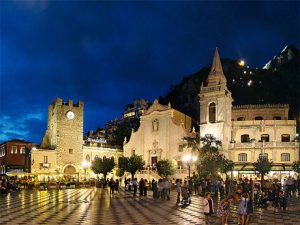
The Caffè Concerto “Mocambo” of the amusing play boy Robertino Fichera was a meeting place for all. Robertino, with his extravagant friends, commissioned a mural in the hall of his famous Café, so that they would remain “immortal”, seated next to Sigmund Freud and Albert Einstein, the true protagonists of the great Taormina theater, among which, in the front row, the famous Chico Scimone and Dino Papale, that “living” humanity, composed of playboys, artists and “crazy” people, who “created” every day the “dolce vita” in Taormina. “Let the party begin” is the title of the mural. But the party was about to end, and also the Robertino earthly life.
The Taormina depersonalization
In 1968, the Belice earthquake brought a wave of fear for the repercussions it could have on tourism. Some tour operators hastily turned to mass tourism, opening up business relations with major European tour operators. So it was that Taormina changed skin. The hotels “sold” the annual contracted rooms to big tour operators of mass tourism, renouncing the individual classic tourism, which until then had made the town so rich and famous.
With mass tourism expanded into the adjacent green areas, it was quickly and disorderly cemented, new hotels and many new businesses were born. Since the Taormina people did not want to devote themselves to the most humble jobs, there was a migration from the backward Sicilian hinterland that often were also improvised hoteliers, restaurateurs and traders. Taormina became, in a short time, a seaside town for a mass tourism from the less elitist services that once.
The hotels now closed in November to re-open at Easter. It was the collapse of almost all the families of ancient Taormina hoteliers who could not adapt to the new times and in few years lost their hotels by selling them to foreign companies that aimed more at budgets than at the quality services.
It was also the end of the dolce vita of Taormina, whose protagonists had been so many extroverts of the Sicilian aristocracy and some charming local playboys who, among the sweetness of the Taormina nature, entertained famous tourists and not, inducing them to return several times during the year in Taormina, just as was the case at the dawn of the century with Geleng and Von Gloeden.
Taormina was therefore “depersonalized“, losing its “identity” of cities of artists and “crazy” in which everyone could live as they could in their city and Taormina risked dying because of the “provincialism” of about many immigrants who they had come there to seek their fortune, and that, having found it and having also been enriched, they had soon occupied the positions of power, thus distorting the city that lost its identity and was invaded by cement, like many other famous tourist cities, because of the “hit and run” tourism favored by a category of daring merchants.
A timid “elitist” rebirth
Above all, the identity of the hospitable and cultured Taormina was lost, also because the historical center was emptied as Taormina people sold their old houses and in their place there were so many second and third houses for vacationers of the province, till when, at the beginning of the third millennium, some entrepreneurs have not started to create luxury hotels again, maisons de charme, which, opened all year round, have in a short time made sure that Taormina is once again a tourist city of international fame, elegant, with a good living room (Corso Umberto I) in which there are beautiful shops with the major world brands and where, thanks to the many prestigious cultural events, one for all Taormina Arte, there is a tourist season that lasts the year with peaks in August and low in January-February and which welcomes both luxury customers and medium-high mass tourism (in summer).
Monuments and interesting places
Places of worship
- San Nicola Cathedral, XII century
- Saint George Church, Anglican place of worship
- Madonna delle Grazie Chapel, 1850
Intra moenia churches:
- Sant’Antonio Abate church, 1330
- San Michele Arcangelo church, 1600c.
- Visitazione church or Varò, XVIII – XIX century
- San Giuseppe church, end of XVII century
- Santa Maria del Piliere church, 1530c.
- Santa Caterina d’Alessandria church, 1610
- San Pancrazio church, VI – IX century
- Santa Domenica church, XVII century
- San Giovanni dei Cavalieri di Malta church, 1533
Extra moenia churches
- San Pietro e Paolo church, XVIII century, re building of a Byzantine temple
- Santa Maria della Rocca church, 1640c.
Other churches
- Santa Maria di Gesù church and San Francesco monastery , 1221.
- Sant’Agata church and monastery of San Domenico order, 1374. Actually accomodating structures famous simply under the name San Domenico.
- Sant’Agostino church and monastery of hermits order, 1486. Today they are civic library and historical archives.
- Sant’Antonio di Padova church and Minor friar monastery (originally called Santa Caterina d’Alessandria «extra moenia» church), 1559.
- Santa Maria del Soccorso church and San Francesco d’Assisi monastery, 1572. They next to San Pancrazio church.
- Assunzione della Beata Maria Vergine church and Minimal San Francesco di Paola order monastery, 1617.
- Santa Maria della Concezione church under the name of Nostra Signora dei Greci and Beata Vergine del Monte Carmelo order monastery, 1622.
- Santa Maria di Valverde and Penitential sister order of Sant’Agostino canonic order about the «Congregazione di Valverde», 1275. This church was destroyed in 1960 and then used like military base for Carabinieri.
- Compagnia di Gesù structures, dated in 1650 and 1658.
Archeological places
- Taormina ancient theatre
- Domus San Pancrazio, I century b.C.
- The Naumachie, I century b.C.
- Odeon, I century b.C.
- Monte Tauro Castle, X century a.C.
Other monuments
- Corvaja Palace
- Duchi di Santo Stefano Palace
- Cipolla House (in Sicilian renaissance style)
- The municipal villa
- Cuseni House (one of the most important example of Arts and Crafts out of United Kingdom).
- Isola Bella
- Taormina-Giardini railway station
- Old Badia
- Sant’Agostino church, actually municipal library
- Trevelyan Cacciola villa (actuallypublic gardens)
Events
The Taormina Greek Theater is the main stage of major events in the city.
There are several events that every year, especially in the summer, are based in Taormina.
Since 1983, the most significant events have been realized within the framework of Taormina Arte, the cultural institution that organizes music, theater and dance festivals. Also included in the program are: the Taormina Film Fest, the Taormina Film Festival, heir to the Cinematographic Film Festival of Messina and Taormina, founded in 1960, which hosted the David di Donatello for twenty years. In the context of the Film Festival, the Silver Ribbons, awards presented by film journalists, are presented at the ancient theater. Since 2005, Taormina Arte has organized, in October, the Giuseppe Sinopoli Festival, an exhibition dedicated to the great conductor, who died in 2001, for years artistic director of Taormina Arte. In Taormina Arte, in the middle of June, every year at the Greek Theater, there is the award ceremony of the International Media Award Taormina Media Award W.Goethe.
